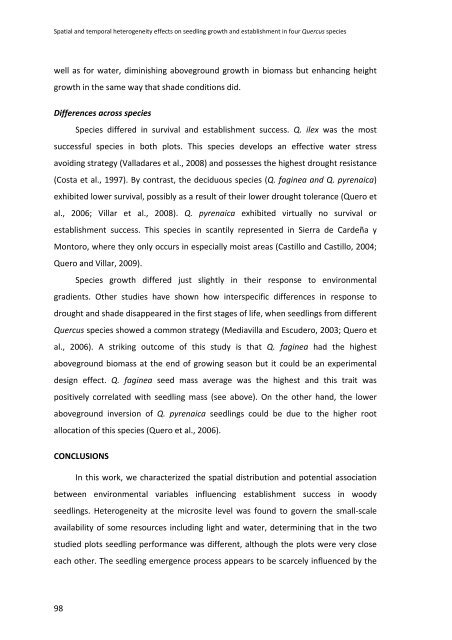Establecimiento de cuatro especies de Quercus en el sur de la ...
Establecimiento de cuatro especies de Quercus en el sur de la ...
Establecimiento de cuatro especies de Quercus en el sur de la ...
Create successful ePaper yourself
Turn your PDF publications into a flip-book with our unique Google optimized e-Paper software.
Spatial and temporal heterog<strong>en</strong>eity effects on seedling growth and establishm<strong>en</strong>t in four <strong>Quercus</strong> species<br />
w<strong>el</strong>l as for water, diminishing aboveground growth in biomass but <strong>en</strong>hancing height<br />
growth in the same way that sha<strong>de</strong> conditions did.<br />
Differ<strong>en</strong>ces across species<br />
Species differed in <strong>sur</strong>vival and establishm<strong>en</strong>t success. Q. ilex was the most<br />
successful species in both plots. This species <strong>de</strong>v<strong>el</strong>ops an effective water stress<br />
avoiding strategy (Val<strong>la</strong>dares et al., 2008) and possesses the highest drought resistance<br />
(Costa et al., 1997). By contrast, the <strong>de</strong>ciduous species (Q. faginea and Q. pyr<strong>en</strong>aica)<br />
exhibited lower <strong>sur</strong>vival, possibly as a result of their lower drought tolerance (Quero et<br />
al., 2006; Vil<strong>la</strong>r et al., 2008). Q. pyr<strong>en</strong>aica exhibited virtually no <strong>sur</strong>vival or<br />
establishm<strong>en</strong>t success. This species in scantily repres<strong>en</strong>ted in Sierra <strong>de</strong> Car<strong>de</strong>ña y<br />
Montoro, where they only occurs in especially moist areas (Castillo and Castillo, 2004;<br />
Quero and Vil<strong>la</strong>r, 2009).<br />
Species growth differed just slightly in their response to <strong>en</strong>vironm<strong>en</strong>tal<br />
gradi<strong>en</strong>ts. Other studies have shown how interspecific differ<strong>en</strong>ces in response to<br />
drought and sha<strong>de</strong> disappeared in the first stages of life, wh<strong>en</strong> seedlings from differ<strong>en</strong>t<br />
<strong>Quercus</strong> species showed a common strategy (Mediavil<strong>la</strong> and Escu<strong>de</strong>ro, 2003; Quero et<br />
al., 2006). A striking outcome of this study is that Q. faginea had the highest<br />
aboveground biomass at the <strong>en</strong>d of growing season but it could be an experim<strong>en</strong>tal<br />
<strong>de</strong>sign effect. Q. faginea seed mass average was the highest and this trait was<br />
positiv<strong>el</strong>y corr<strong>el</strong>ated with seedling mass (see above). On the other hand, the lower<br />
aboveground inversion of Q. pyr<strong>en</strong>aica seedlings could be due to the higher root<br />
allocation of this species (Quero et al., 2006).<br />
CONCLUSIONS<br />
In this work, we characterized the spatial distribution and pot<strong>en</strong>tial association<br />
betwe<strong>en</strong> <strong>en</strong>vironm<strong>en</strong>tal variables influ<strong>en</strong>cing establishm<strong>en</strong>t success in woody<br />
seedlings. Heterog<strong>en</strong>eity at the microsite lev<strong>el</strong> was found to govern the small‐scale<br />
avai<strong>la</strong>bility of some resources including light and water, <strong>de</strong>termining that in the two<br />
studied plots seedling performance was differ<strong>en</strong>t, although the plots were very close<br />
each other. The seedling emerg<strong>en</strong>ce process appears to be scarc<strong>el</strong>y influ<strong>en</strong>ced by the<br />
98

















